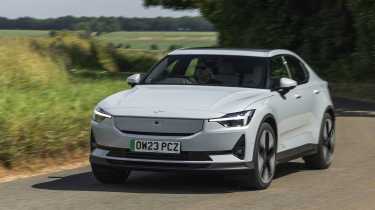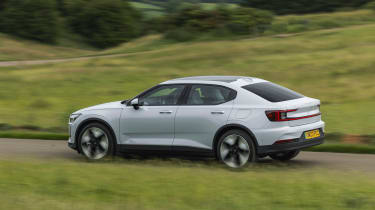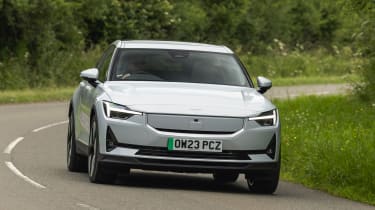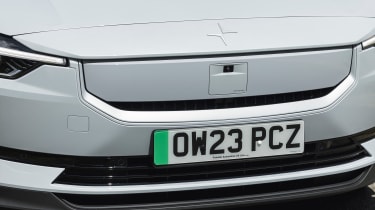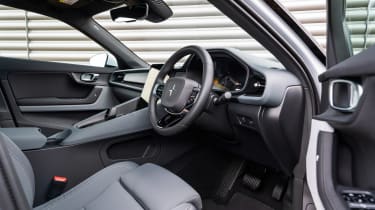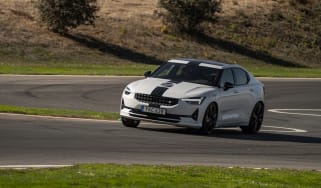Polestar 2 review – Sweden’s answer to the Tesla Model 3
The Polestar 2 strikes a good balance between range, performance and engagement, but it's not as sharp as some alternatives
Polestar has been hard at work expanding its range beyond just a single model over the last few years, launching the 3 SUV, 4 crossover and soon, the 5 saloon. These models are designed to help Polestar compete in an ever-changing and increasingly competitive EV market, but its very first model, the 2, remains most significant of all.
Tackling the lower end of the market to rival models like the Tesla Model 3, the Polestar 2 doesn’t have an easy job on its hands. A comprehensive update in 2023 saw Polestar completely overhaul the entry-level 2 to make it a more competitive offering, and with boosted performance and improved efficiency across the board, it did just that. Its closest rival, the Tesla Model 3, has always offered a competitive blend of style, tech and dynamic ability though, so can its Swedish alternative still compete?
> Polestar 4 review – 536bhp crossover is the fastest yet
Powertrain and technical highlights
The Polestar 2 is offered in two motor configurations, with either a single rear motor or dual-motor all-wheel drive. The entry-level car has 268bhp and 361lb ft of torque, powered by a 70kWh battery pack for 344 miles (WLTP) of range. Jump up to the next model and the single-motor ‘Long Range’ car is what you’ll get, pairing a more powerful 295bhp rear motor with a larger 82kWh battery pack – the result is a 408-mile range (WLTP), the highest of any Polestar 2.
More reviews
Stepping up to the dual-motor version raises peak power to 416bhp and 546lb ft, with 369 miles of range offered from that 82kWh battery. In tandem with chassis upgrades, the Performance Pack brings an extra 53bhp to lift the total to 469bhp (torque is rated the same as the standard dual-motor setup), with range dropping to 352 miles. By comparison, the Tesla Model 3 uses a slipperier body design than the original to achieve a quoted range of 323 miles in its cheapest rear-wheel drive form, with the single-motor Long Range version providing a huge 466 miles from a full charge.
Under the Polestar’s skin is a modified version of Volvo’s CMP platform with a battery pack running through the floor. The Polestar 2 is proportioned differently to the XC40 SUV to which it is related, at 4.6m long and 1.85m wide. For reference, a Tesla Model 3 is around 100mm shorter and 100mm wider.
On a mixed driving route that included town driving, motorway cruising and more demanding B-roads (and with no effort to conserve energy), our average consumption was 28.6kWh per 100 miles, which equates to a projected range of 287 miles. With a more conservative driving style over 300 miles should be easily achievable, and while that's some way off the WLTP figure, it's on par with the BMW i4 eDrive35's claimed range.
Performance, ride and handling
Although Polestar prides itself on being a performance brand, the Polestar 2’s overall technical make-up is pretty standard, with MacPherson struts up front and a multi-link rear. Specify the Performance Pack and the mechanical specification is boosted through the use of adjustable Öhlins dampers and a chunkier brake package, but the 2 isn't an especially sporty machine at its core.
In the base model, the Polestar 2’s performance is all it needs to be to capture that impressive first impression of a well-endowed electric car. Even the single-motor feels hot hatch quick up to motorway speeds (0-62mph comes up in 6.2sec), and the extra power and four-wheel drive traction of the dual-motor version give it sports car beating pace, sprinting from 0-62mph in just 4.3sec. The Performance Pack shaves a further three tenths from that, and while no Polestar 2 offers the sheer thrust of a Model 3 Performance, you’ll rarely be looking for much more power.
There are no performance-enhancing driver modes within the Polestar’s interfaces, although drivers can choose one of three levels of regenerative braking which vary between a Nissan Leaf-like one-pedal driving characteristic that will bring you to a complete stop, and right through to a coasting level that has no regen until you hit the brakes – when you do, the hydraulic brakes are strong, easy to modulate and inspire good confidence in the range-topping Performance model. Throttle mapping is well calibrated no matter the setting, with smoother modulation than the more expensive Polestar 4.
But while performance is impressive, it’s always measured and under control in the four-wheel drive models. Even heavy throttle applications on broken surfaces don’t upset the Polestar 2’s composure, with seamless and trustworthy traction. Put it into its ESP Sport mode, and it’ll allow even more liberal applications of power from all four wheels, revealing an even clearer window into the impressive balance that’s been engineered into the chassis. The instant swell of torque can occasionally overwhelm the rear tyres in the single-motor layout, but it still feels controllable and intuitive.
Despite Polestar's self-proclaimed positioning as a driver-focused manufacturer, there isn't much to engage you at normal speeds. The steering feels light and lacks the crispness of a BMW i4's (even if neither are especially communicative), the ride feels busy and brittle and the raised driving position isn't especially purposeful.
The Performance model with its Öhlins dampers doesn’t improve matters much, as while its suspension hardware is significantly more focused, you don’t get much back in terms of a rewarding drive. The weight of the car still makes itself known in the Performance, with it struggling to control its body on trickier roads, failing to provide you with the confidence you really need. The ride is brittle at low speeds, the steering still lacks feel and despite its Performance badge, the rack is oddly slow too.
Interior and tech
Drop into the Polestar 2 and the high scuttle and shallow windows make the cabin feel instantly enveloping, something very different from the open-air feeling of the Model 3. Like Teslas, Polestar has done away with any form of starter button, instead it’s as simple as stepping in and knocking the gear selector back (twice) into D and you’re off. There’s not even an electric handbrake, instead it automatically engages when you reselect P.
The Polestar 2’s five-seat interior is about equivalent in size to that of a BMW 3-series saloon, but the high scuttle can make the rear of the car feel quite tight. The use of a standard-fit, full-length panoramic sunroof helps matters considerably though, bringing plenty of light into the cabin and improving the rear seat experience in the process – opt for light interior upholstery and it’s a very pleasant place to be.
Materials, design and build quality put the Polestar 2 ahead of most of its rivals at this price point, elevating the cabin feel to beyond that of a BMW i4 or Tesla Model 3. Artful use of fabric and wood trims add another layer of depth and warmth to the aesthetic that not many other manufacturers can pull off – the use of ‘Swedish Gold’ seatbelts in the Performance is a nice touch too, catching the eye before you’ve opened the door. Cast your eyes lower down in the cabin and it’s not hard to find cheaper materials, but there’s no doubt Polestar has invested in using the right materials in the right places.
Dominating the driver’s aspect is a glossy upright tablet-style screen that mimics the path initially taken by Volvo and improves it with its Google-designed interface and clean graphics. Where a Tesla can feel stark, and almost submersible-like, the Polestar is more relatable to the mainstream, but with a definite edge in design, quality and operations. While the Polestar 2 does support Apple CarPlay and Android Auto in addition to its Google system, it is worth noting that unlike virtually every other car on sale today, you’ll need a physical wire to make it function.
There are a few ergonomic issues, as even in the range-topping Performance model the seat doesn’t drop quite as low as we’d like. The few physical controls you’ll find in the cabin, such as the window controls, are placed in an awkward position on the door card, forcing you to contort your hand to reach them.
Prices, specs and rivals
The Polestar 2 range kicks off with the single-motor variant, which is available with two battery options – Standard and Long Range. These cost £45,160 and £49,160 respectively, while the dual-motor is only available with the bigger battery and commands £53,160. The dual-motor Performance Pack tops the tree with a starting price of £56,159.
The entry-level Tesla Model 3 now has a less competitive 323-mile range and less performance than the base Polestar 2, but its £39,990 starting price makes it good value. Opt for the next model up and the £44,990 single-motor Long Range car gets you a 466-mile range and a good performance boost, making the equivalent Polestar 2 look less attractive still. At the top of the range is the Model 3 Performance with a 2.9sec 0-60mph time and a 354-mile range for £59,990, with its considerable performance advantage probably worth the slight price premium over the range-topping Polestar 2.
The BMW i4 is another competent EV which, despite its ICE-derived underpinnings, is one of the most polished and cohesive cars to drive in the class. Its packaging and rear seats are a touch compromised compared with pseudo-crossovers like the Polestar 2, but the i4 counters with exceptional interior quality and crisp dynamics to give the Polestar a real headache. It costs from £51,370 in its most basic eDrive35 form.
Polestar 2 Performance specs
| Engine | Dual-motor, all-wheel drive |
| Power | 469bhp |
| Torque | 546lb ft |
| Battery | 82kWh |
| Range | 352 miles WLTP |
| 0-62mph | 4sec |
| Top speed | 127mph |
| Basic price | £53,160 |
